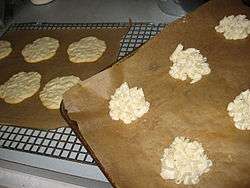Jumble (cookie)
|
Buttermilk jumbles | |
| Alternative names | Jambles, jumbals, jumbolls, jumbolds, jumballs, jambal, jemelloe, gemmel |
|---|---|
| Type | Cookie |
| Place of origin | Italy or Middle East |
| Main ingredients | Nuts, flour, eggs, sugar |
|
| |
Jumbles (other spellings Jambles, Jumbals, Jumbolls, Jumbolds, Jumballs) are cookie-like pastries, common in England and abroad since the Middle Ages, which tend to have a relatively simple recipe of nuts, flour, eggs, and sugar, with vanilla, anise, or caraway seed used for flavoring. They were formerly often made in the form of rings or rolls.
Jumbles were known by many variations on the basic name, including jambal, jemelloe, and gemmel. They were widespread, specifically because they travelled well, thanks to their very dense, hard nature. They could be stored for up to a year without becoming too stale. Because of their density, they were sometimes twisted into knots before baking, in order to make them easier to eat, generating knots as another common name.
Jumbals were traditionally shaped in intricate loop or knot patterns, usually of rolled out dough. Early flavouring agents were aniseed, coriander, caraway seeds and rosewater.[1] Later, jumbles referred, especially in the United States, to a thin crisp cake or cookie[2] using e.g. lemon-peel as a flavouring agent.
In Australia, Arnotts manufactures a related product called Honey Jumbles.[3]
History
Jumbles were widespread in Europe by the 17th century,[4] but possibly originated in Italy as the cimabetta. A very common cookie for travelers, they probably were brought to America on the Mayflower, if not Jamestown previously. There is even a famous recipe credited to Martha Washington.
Originally, jumbles were twisted into various pretzel-like shapes, and boiled. By the late 18th century, jumbles became rolled cookies that were baked, producing a cookie very similar to a modern sugar cookie, although without the baking powder or other leavening agents used in modern recipes.[5]
Etymology
The word "jumble" is derived from the French jumelle, meaning "twin", because of their shape.[5] The use of the word "jumble" for cookie predates the use of the word "jumble" to indicate "a mixture of stuff", possibly allowing for the pastry as the origin of the modern meaning.[6]
Notes
- ↑ Wolley, Hannah: The Queen-like Closet, 1672
- ↑ Randolph, Mary: The Virginia Housewife, 1831
- ↑ "Honey Jumbles". Our Products. Arnotts. 2005. Archived from the original on 20 July 2008. Retrieved 2008-10-19.
- ↑ Oxford English Dictionary, second edition, 1989.
- 1 2 "historic recipe for jumbles, Fort York". Archived from the original on 26 May 2009. Retrieved 8 June 2009.
- ↑ "Jumble". Reference.com.
